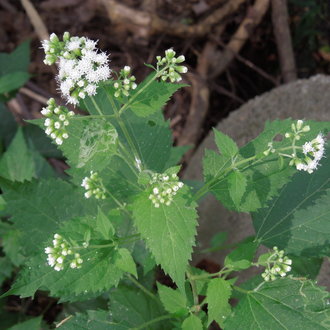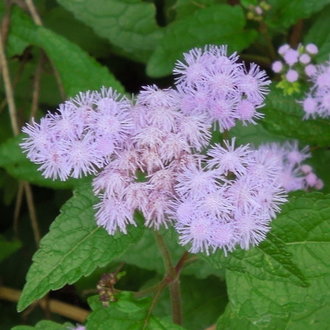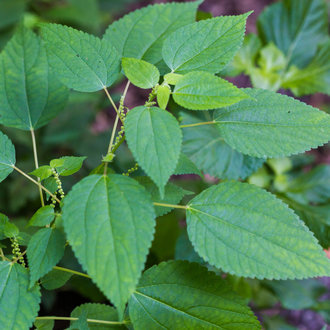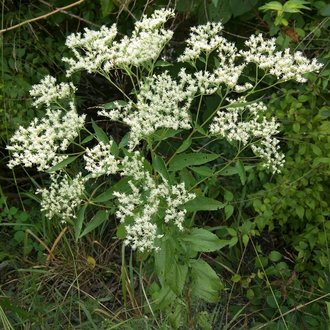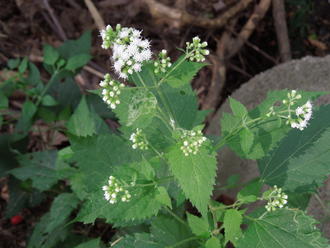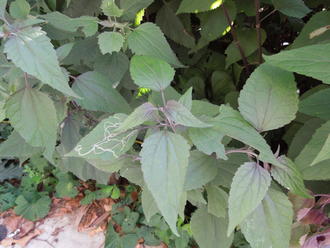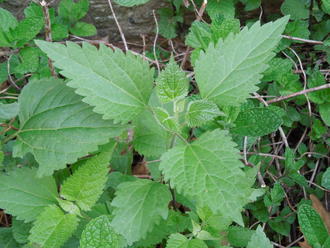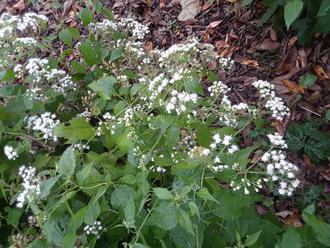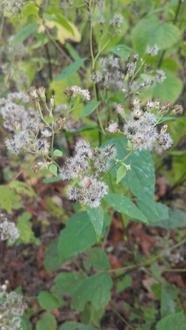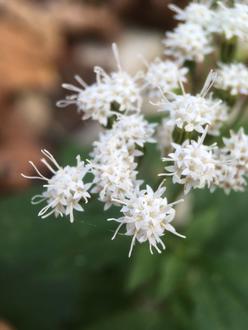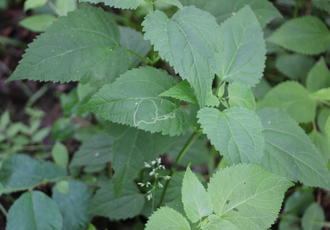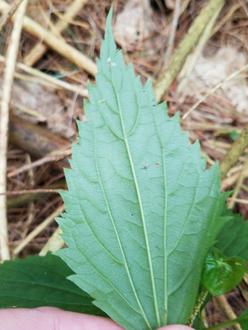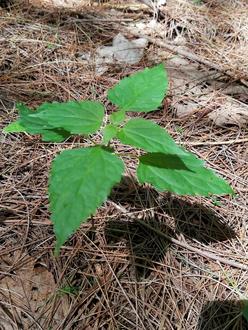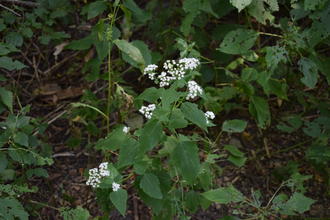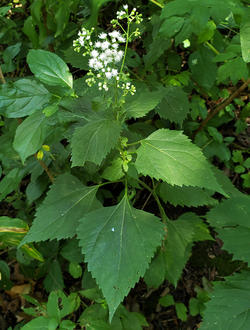White Snakeroot (Ageratina altissima (L.) R.M. King & H. Rob.)
Also classified as Eupatorium rugosum Houtt.
↑Summary
A poisonous perennial herb native to eastern North America. One of the most common members of the Eupatorieae tribe of the aster family. In much of its range, among the last wildflowers to bloom in fall.
↑Range - Expand
| Legend | Color |
| Native | |
| Native or Not Present |
This tentative map is based on our own research. It may have limited data on Canada and/or Mexico, and there is some subjectivity in our assignment of plants as introduced vs. expanded. Read more in this blog post.
Although this plant occurs somewhere in each of these regions, it may only occur in a small part of some or all of them.
↑Description & Identification
Typically 1½-3' tall, often taller in moister conditions and more fertile soil and where competing for light. It usually has opposite leaves (rarely whorled), branching occasionally, typically forming a neat, symmetrical growth habit. Leaves sharply serrate. Flowers white. Flowerheads with 12-25 florets, in clusters often with some space between individual flowerheads.
↑Similar Plants
↑Habitat
Deciduous woodlands, especially open woods and woodland borders. Found in conditions ranging from moist conditions is sun to slightly dry areas in light shade, but usually in well-drained soils. Adaptable to a broad range of conditions.
Common and often abundant in partly-shaded disturbed habitats, including small, fragmented sections of woods along roadways and railroads, and wooded areas in urban, suburban, and industrial areas. Often grows underneath hedges and shrubbery in suburbs. Many of these populations are escapes from cultivation.
↑Life Cycle
Ageratina altissima is an herbaceous perennial. It can spread vegetatively by short rhizomes, but often grows with a clumping growth habit and is more likely to spread by seed, with each clump growing more dense and vigorous each year.
First year plants usually flower and set seed, but the plant usually grows larger and produces much more seed in its second and later years.
The above-ground parts are sensitive to cold and frost, and usually die down completely after a moderately hard frost. As this plant is late to flower and set seed, and often grows in partly-shaded areas that stay somewhat cooler, its pollination and seed production can be sensitive to weather conditions in fall. An early hard frost can halt its reproduction for the year, and prolonged cold temperatures can hinder its pollinators.
It can sometimes colonize areas with north-facing exposures due to buildings or steep slopes, where it initially thrives during the brightest months, but ends up with insufficient light to successfully flower and set seed late in the season.
↑Faunal Associations
This species is consistently eaten by leaf miners and aphids.
The flowers attract a large variety of pollinators, including bees, butterflies, moths, and flies.
The foliage is toxic to mammals and as such it is usually avoided by most mammals. Cows can occasionally be pushed to browse on this plant in overgrazed pastures, which can be dangerous as the toxin can be passed through the cow's milk.
↑Uses
Cultivated as an ornamental plant, although it can sometimes become aggressive in garden conditions, outcompeting other plants. A dark purple leafed cultivar, "Chocolate snakeroot" is most commonly cultivated; often, local populations established from this cultivar can show considerably more purple on the leaves than truly wild populations.
Used in ecological restoration projects, as it is easy to get established, competes favorably against invasive plants, thrives in disturbed habitats, resists browsing by deer, and has high value to insects and birds.
This plant may have had some historical medical uses, but all parts of the plant are poisonous.
↑Related Plants
White snakeroot has numerous close relatives. There are 11 different Ageratina species native to North America, and one introduced one, but only one overlaps with this species in range. In the southeast, A. altissima is replaced by lesser snakeroot (Ageratina aromatica), but there is a broad region in which they overlap, mostly in the Piedmont and to a lesser degree the coastal plain. In most regions however, Ageratina altissima will be the only plant of its genus.
In the broader Eupatorieae tribe, there are many other genera that occur together with this species, including Conoclinium, Eupatorium, Eutrochium, and many others.
Of these, the most visually similar plants are blue mistflower (Conoclinium coelestinum), which is shorter and has pink-blue-lavender flowers and more rounded leaf tips, and late boneset (Eupatorium serotinum), which is taller and has lightly longer, more slender leaves. Both prefer sunnier, wetter areas.
Of the closely related plants, white snakeroot is usually the most shade tolerant and particularly the most tolerant of slightly dry shade, but compared to most of these other species, is less tolerant of poorly-drained soils.
↑Links & External Resources
• Ageratina altissima (White Snakeroot) | Illinois Wildflowers (About This Site)
• Ageratina altissima (White Snakeroot) | USDA PLANTS Database (About This Site)
• Ageratina altissima | Go Botany (About This Site)
• Ageratina altissima (White Snakeroot) | Missouri Botanical Garden Plant Finder (About This Site)
• Ageratina altissima | Biota of North America Project (BONAP) (About This Site)
• Ageratina altissima | NatureServe Explorer (About This Site)
• Ageratina altissima | Flora of North America (About This Site)
• Ageratina altissima | Missouri Plants (About This Site)
• White Snakeroot | Maryland Biodiversity Project (About This Site)
• Ageratina altissima (White Snakeroot) | Minnesota Wildflowers (About This Site)
• Ageratina altissima (L.) King & H.E. Robins. var. altissima (White Snakeroot) | Digital Atlas of the Virginia Flora (About This Site)
• Ageratina altissima (L.) King & H.E. Robins. var. roanensis (Small) Clewell & Wooten (Appalachian White Snakeroot) | Digital Atlas of the Virginia Flora (About This Site)



